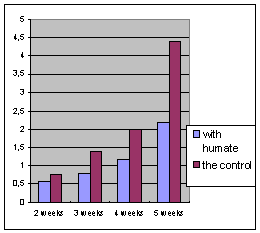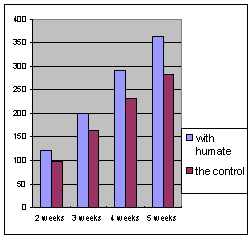

CONTENTS
Please
note, this "book" has been translated into English from its Russian
form. Any small grammatical flaws that occur are simply the result of this
translation.
9. Humates in
Poultry and Stock Farming
A unique capacity of humic preparationís is to effectively intensify
metabolic processes in vegetable cells. A
series
of important scientific tests have shown that this is also evident in relation
to animal organisms. The use of
humic preparations, as part of a food supplements, has been fully
researched using highly productive broiler poultry. It was established that the use of
humates in broilersí feed activated the synthetic phase of albuminous
exchange. As a result, there was a
10% increase in mass growth, and the poultryís immunity rose by 5%-7%.
In the course of these experiments,
soluble humate was added to the feed at 250
mg per 1 kg of feed, starting from the age of twenty days.
In August of 1996, the industrial experiments were carried out together with the Megetskaya poultry farm in the
Irkutsk region. Sodium humate in
the form of a water solution containing 1 gram of sodium humate to 1 liter of
drinking water was given to chickens from the day they hatched.
This experiment not only confirmed the high efficiency of the
preparation, but it also provided new data.
The experiment was carried out on 11,000 chickens under the unfavorable conditions, where the quality of the incubated eggs was substantially below
standard. The results showed that
the exchange of vitamins and antibiotics for sodium humate in the feed caused a
decrease in the poultry losses for the first forty days by 47%.
At the same time, their average weight gain increased by 10%.
Once more, this data supports the brilliant hypothesis by L. A. Khristeva,
who first suggested the high efficiency of the humates under unfavorable conditions. In 1998, similar tests
were carried out on a wide scale at the Severny pedigree poultry breeding state
farm near the town of Bratsk. The
results, shown in the following diagram (See Fig. 12), confirmed the previous data. The poultry losses decreased by 50%, while the active (live)
weight in five weeks increased by 30%.
| A | B |
 |
 |
Fig.
12. The effect of the humate supplements on poultry loss (a) and active (live)
weight gain in poultry (b).
Very important results were also accumulated when humates were used in
stock-breeding. In one review, it was noted that the general effectiveness of
the fodder increased by 10%-20% when 1% humic acid was added to the fodder. This
effect was explained because the addition of the humates is conducive to the
increase of red blood cells in sheep. Detailed
research was carried out on
2 groups of animals: calving cows and new-born
bull-calves. For 21 to 30 days, the animals in both groups were fed sodium
humate at 10 mg per 10 kg of active (live) weight, in addition to the fodder.
(N. Maslov and others, 1983.) It
was observed that the calves born from cows that have been fed humates, within
four months had a 13.4% increase, when compared to the control group. The bull-calves that had been fed with humates, had an increase of 21.2%,
compared to the control group. The haematological data of animals in both humate-fed groups showed the animals had
high metabolism. For example, the
blood tests on experimental animals showed the haemoglobin level increasing by
11.5%, the phosphorus level increasing by 6.7%, the albumen level increased by 24.3%, and the beta-globulin level
increased by 32%. Professor L. Khristeva had obviously developed a physiologically active
concentrate of humic acid. The
experiments showed that this preparation had a wide spectrum of pharmacological
and anti-toxic characteristics. The
use of humic preparations by veterinary science was based on these experiments.
Obviously, the next step would be to create medications based on humic
acids. A serious scientific base
already exists. The research
carried out by T. Lotosh established high anti-toxic effect of humate
preparations educed from peat (sodium humate).
G. Pulkovoi, along with his colleagues, demonstrated the therapeutic
effect of sodium humate, when rats were exposed to lethal dose of X-rays.
A preparation containing fulfonic acids and colloidal silver was created;
it is used to effectively improve general health.
Interestingly, the idea of creating this preparation was adopted from the
recipes of ancient Chinese medicine from the XV century.